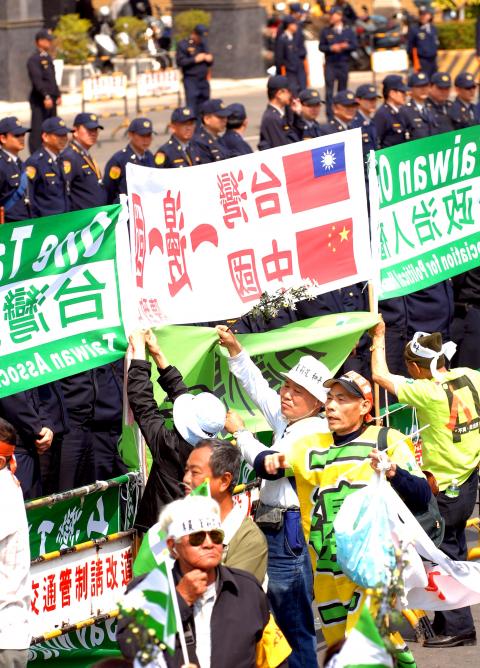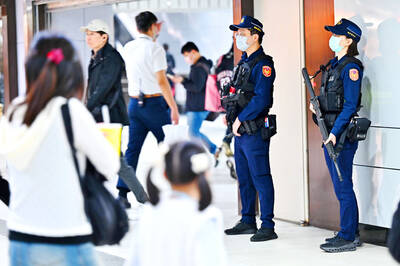Protesters from around the country yesterday converged in Greater Kaohsiung, the first stop of Association for Relations Across the Taiwan Strait Chairman Chen Yunlin’s (陳雲林) first trip to southern Taiwan, for a second day of protest.
Small groups of rowdy demonstrators streamed into key venues throughout Chen’s visit, including E-DA World, the tourist complex where Chen was staying and had lunch with local Chinese Nationalist Party (KMT) politicians and business executives.
Their signs bore messages stating that Chen was not welcome in the southern city, a hotbed of support for the Democratic Progressive Party (DPP), which opposes the visit.

Photo: Huang Chih-yuan, Taipei Times
Clashes almost erupted at the Taiwan High Speed Rail station in the morning when Chen and his entourage were met by dozens of pro-independence supporters and advocates of unification with China.
Chen continued to keep a smile on his face as protesters from the two sides, blocked off by rings of uniformed police, yelled that “Taiwan and China are separate countries,” and “Peaceful unification will give peace to all things.”
Pro-independence supporters, numbering between 150 and 200, continued to tail Chen as he visited the Port of Kaohsiung for an economic conference, the Fo Guang Shan monastery and an export processing zone in the northern part of Greater Kaohsiung.
“Support Taiwan independence,” the protesters chanted, as some threw eggs and chrysanthemums in the direction of Chen’s motorcade. They said the chrysanthemums, in a reference to the “Jasmine Revolution,” served as a substitute, since it is not the season for jasmine.
None of the projectiles hit the passing vehicles, as the demonstrators were kept at a distance by a large police presence, who formed a human barrier backed by barricades and barbed wire.
Police were forced to intervene when several local DPP politicians broke through barriers at one point during the morning visit to the Port of Kaohsiung.
The municipal councilors staged a sit-in after failing to break past the second of four more barbed-wire barricades separating them and a building where Chen addressed a closed-door economic conference, despite pushing and shoving with police.
Busloads of protesters, most of them elderly, arrived from Taipei, Greater Taichung and other cities, led by pro-independence groups and local DPP politicians, keeping a pledge to tail Chen “like his shadow” during his three days in the south.
“It’s a fact — Taiwan and China are two separate countries. Each side of the Taiwan Strait is an independent country,” said Huang Yung-tien (黃永田), a retired pilot from Greater Tainan. “Why must Chen Yunlin come here acting otherwise?”
A few joined the demonstration out of curiosity, drawn by the emotional speeches given by protest leaders.
Yang Fung-kuang (楊豐光), a 30 year-old who said he was in the city for the Lantern Festival, criticized President Ma Ying-jeou’s (馬英九) cross-strait policies, contending they were skewed too much in favor of Chinese interests.
“The [lavish] treatment given to Chen Yunlin shows exactly what is wrong with these policies,” Yang said.
A transportation worker surnamed Lu (盧) told the Agence France Presse: “It’s good that Chinese companies come to Kaohsiung to invest, but I worry that China is using economic means to back its real intention of unification.”
Falun Gong supporters also waved banners. About 20 silently prayed on the road leading up to Chen’s hotel, calling on China to respect freedom of religion.
The DPP itself has stopped short of endorsing the protests — despite praising them for showing Chen what they say is another side of Taiwan. The party over the past week called on local authorities to respect the demonstrations, calling the protests a basic right.
A prominent force during the protests was former president Chen Shui-bian’s (陳水扁) son, Greater Kaohsiung Councilor Chen Chih-chung (陳致中), who whipped the crowd into a frenzy in front of the main gates of E-DA World, less than 50m from where Chen Yunlin was staying.
“Taiwan is a democratic country — we don’t want China,” Chen Chih-chung said. “Together we will make ourselves heard to Chen Yunlin that Taiwan and China are two different countries.”
The protests wrapped up at about 6pm after Chen Yunlin did not publicize the rest of his schedule for the night. Nonetheless, organizers said busloads of protesters would continue to follow him as he heads to Chiayi County today and then Yunlin County tomorrow.
In Taipei, Su Jun-pin (蘇俊賓), director of the KMT’s Culture and Communication Committee, said that while the pan-green supporters’ freedom to express opinions should be respected, they should also remain calm so that “Taiwan’s image does not suffer.”
Referring to the DPP’s new cross-strait discourse unveiled on Wednesday, Su said the protests staged by pan-green supporters were ironic in the face of DPP Chairperson Tsai Ing-wen’s (蔡英文) remarks that Taiwan and China must maintain peace by tolerating differences and seeking common ground.
“The protest is tantamount to proclaiming to Taiwanese that the DPP’s new cross-strait policies are simply the same thing in a new wrapper,” Su said.
ADDITIONAL REPORTING BY LIN SHU-HUI AND AFP

TRAGEDY STRIKES TAIPEI: The suspect died after falling off a building after he threw smoke grenades into Taipei Main Station and went on a killing spree in Zhongshan A 27-year-old suspect allegedly threw smoke grenades in Taipei Main Station and then proceeded to Zhongshan MRT Station in a random killing spree that resulted in the death of the suspect and two other civilians, and seven injured, including one in critical condition, as of press time last night. The suspect, identified as a man surnamed Chang Wen (張文), allegedly began the attack at Taipei Main Station, the Taipei Fire Department said, adding that it received a report at 5:24pm that smoke grenades had been thrown in the station. One man in his 50s was rushed to hospital after a cardiac arrest

A car bomb killed a senior Russian general in southern Moscow yesterday morning, the latest high-profile army figure to be blown up in a blast that came just hours after Russian and Ukrainian delegates held separate talks in Miami on a plan to end the war. Kyiv has not commented on the incident, but Russian investigators said they were probing whether the blast was “linked” to “Ukrainian special forces.” The attack was similar to other assassinations of generals and pro-war figures that have either been claimed, or are widely believed to have been orchestrated, by Ukraine. Russian Lieutenant General Fanil Sarvarov, 56, head

SAFETY FIRST: Double the number of police were deployed at the Taipei Marathon, while other cities released plans to bolster public event safety Authorities across Taiwan have stepped up security measures ahead of Christmas and New Year events, following a knife and smoke bomb attack in Taipei on Friday that left four people dead and 11 injured. In a bid to prevent potential copycat incidents, police deployments have been expanded for large gatherings, transport hubs, and other crowded public spaces, according to official statements from police and city authorities. Taipei Mayor Chiang Wan-an (蔣萬安) said the city has “comprehensively raised security readiness” in crowded areas, increased police deployments with armed officers, and intensified patrols during weekends and nighttime hours. For large-scale events, security checkpoints and explosives

PUBLIC SAFETY: The premier said that security would be tightened in transport hubs, while President Lai commended the public for their bravery The government is to deploy more police, including rapid response units, in crowded public areas to ensure a swift response to any threats, President William Lai (賴清德) said yesterday after a knife attack killed three people and injured 11 in Taipei the previous day. Lai made the remarks following a briefing by the National Police Agency on the progress of the investigation, saying that the attack underscored the importance of cooperation in public security between the central and local governments. The attack unfolded in the early evening on Friday around Taipei Main Station’s M7 exit and later near the Taipei MRT’s Zhongshan